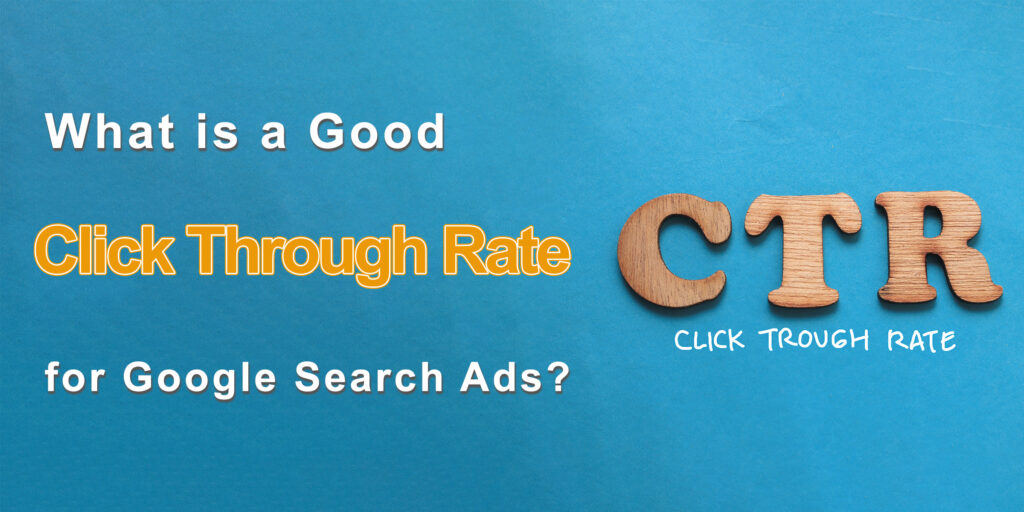In the current digital environment, where information is at our fingertips, Google Search Ads have become an integral part of marketing strategies for businesses of all sizes. These ads offer a unique opportunity to connect with potential customers actively searching for products or services. However, to maximize the effectiveness of Google Search Ads, understanding and optimizing the click-through rate (CTR) is essential. In this article, we’ll explore what CTR is, industry benchmarks, and strategies to improve your campaign’s CTR for better results.
1. Understanding Click-Through Rate (CTR)
Before delving into the specifics of what your Google Search Ads CTR needs to be, it’s important to grasp the concept of CTR itself. Click-Through Rate is a metric that measures the effectiveness of your ad in enticing users to click on it. It is calculated by dividing the number of clicks your ad receives by the number of times it is shown (impressions).
CTR = (Number of Clicks / Number of Impressions) * 100
For example, if your ad receives 100 clicks from 2,000 impressions, your CTR would be 5%.
2. Industry-Level Benchmarks
One of the key factors to consider when assessing your Google Search Ads CTR is industry benchmarks. Across various industries, CTR can vary significantly due to differences in user behavior, competition, and the nature of products or services being advertised.
As a general guideline, the industry-level CTR for Google Search Ads tends to hover around 5%. However, it’s crucial to note that this is a broad average and that different industries may experience significantly different CTRs. For instance, highly competitive industries such as finance or legal services may have lower CTRs, while niche markets may achieve higher CTRs.
Here’s a breakdown of some industry benchmarks to provide context:
E-commerce: E-commerce businesses often aim for a CTR of around 4-6%, as users actively search for products.
Finance and Insurance: Highly competitive industries, like finance and insurance, may have CTRs closer to 2-3% due to the complexity of products and services.
Health and Wellness: Health and wellness products or services may see CTRs between 5-7% as users often search for solutions to their health-related needs.
Travel and Tourism: This industry may experience CTRs between 4-6%, with seasonal variations.
Technology: The technology sector can vary, but a CTR of 4-7% is often the target range.
Remember, these benchmarks are not set in stone, and individual campaign performance can deviate from these averages. It’s crucial to assess your campaign’s performance based on your specific industry and goals.
3. When to Revisit Your Campaign
While industry benchmarks provide a useful reference point, your campaign’s performance should be evaluated against its unique objectives. If your campaign’s CTR falls significantly below the industry benchmark for your sector, it’s time to revisit your campaign settings and strategies.
Here are some key indicators that suggest it’s time for a campaign review:
Low CTR: If your campaign consistently achieves a CTR well below the industry average, it may indicate that your ads are not resonating with your target audience.
Low Conversion Rate: Another sign is a low conversion rate. If your CTR is decent but your conversion rate is lagging, it suggests that your ads might be attracting clicks from users who are not genuinely interested in your products or services.
High Costs: If your Cost Per Click (CPC) is high, but your CTR is low, you’re spending a lot of money on clicks that don’t convert into customers. This is a clear signal that adjustments are needed.
Ad Fatigue: If your campaign has been running for a while and the CTR is steadily declining, it’s possible that users have grown tired of seeing the same ad. Ad fatigue can negatively impact CTR.
4. Strategies to Improve Your CTR
Once you’ve identified that your campaign’s CTR needs improvement, it’s time to implement strategies to boost it. Fortunately, there are several tactics and best practices you can employ to enhance your Google Search Ads CTR.
1) Keyword Optimization
Keywords play a pivotal role in the performance of your Google Search Ads. To improve your CTR, consider the following keyword optimization strategies:
Keyword Relevance: Ensure that your chosen keywords align closely with your ad’s content and the user’s search intent. Irrelevant keywords can result in lower CTR.
Negative Keywords: Use negative keywords to filter out irrelevant search queries that might trigger your ads. This helps improve CTR by ensuring your ads are shown to a more targeted audience.
Long-Tail Keywords: Incorporate long-tail keywords into your campaign. These are specific phrases that often have less competition and can attract more qualified clicks.
2) Ad Copy and Extensions
Crafting compelling ad copy and leveraging ad extensions can make your ads stand out and encourage more clicks:
Compelling Headlines: Create attention-grabbing headlines that address the user’s pain points or desires.
Clear Call-to-Action (CTA): Include a strong CTA that tells users what action to take. Phrases like “Shop Now,” “Learn More,” or “Get Started” can be effective.
Ad Extensions: Utilize ad extensions like site link extensions, callout extensions, and structured snippet extensions to provide additional information and entice users to click.
3) Quality Score and Ad Relevance
Google assigns a Quality Score to your ads, which takes into account the relevance of your ad copy, keywords, and landing page. A higher Quality Score can positively impact your CTR:
Landing Page Experience: Ensure that your landing page provides a seamless and relevant user experience. A well-optimized landing page can improve ad relevance and CTR.
Ad Relevance: Make sure that your ad copy aligns with your chosen keywords. Users are more likely to click on ads that directly address their search queries.
4) Ad Scheduling and Bid Strategy
Optimizing your ad scheduling and bidding strategy can help you reach your target audience at the right time:
Dayparting: Use ad scheduling to display your ads during peak hours when your target audience is most active.
Bid Adjustments: Adjust your bids based on factors like device type, location, and time of day to maximize the visibility of your ads to high-potential users.
5) Ad Testing and Experimentation
Regularly testing different ad variations can help you identify which elements resonate most with your audience:
A/B Testing: Run A/B tests to compare different ad headlines, descriptions, and CTAs to determine which combinations perform best.
Ad Rotation: Experiment with ad rotation settings to evenly distribute impressions among your ad variations.
6) Audience Targeting
Refining your audience targeting can increase the relevance of your ads:
Audience Segmentation: Segment your audience based on demographics, interests, or behavior to deliver more tailored ads.
Remarketing: Use remarketing campaigns to re-engage users who have previously interacted with your website but did not convert.

5. The Impact of Improved CTR on Conversion Rate
One of the significant benefits of optimizing your Google Search Ads CTR is its potential to positively impact your conversion rate. While CTR measures the effectiveness of getting users to click on your ad, conversion rate measures how many of those clicks turn into valuable actions, such as making a purchase or filling out a contact form.
By employing the strategies mentioned above to increase your CTR, you can attract more qualified traffic to your website. When users find your ad and landing page relevant to their needs, they are more likely to convert. This alignment between ad and landing page can lead to a significant boost in conversion rate.
For example, let’s say your campaign initially had a CTR of 2%, and your conversion rate was 2%, resulting in one conversion for every 100 clicks. After optimizing your CTR to 5% through improved ad relevance and targeting, your conversion rate might increase to 4%, yielding four conversions for the same 100 clicks. This demonstrates the direct correlation between CTR and conversion rate.
Conclusion
In the world of Google Search Ads, understanding what your CTR needs to be is crucial for achieving marketing success. While industry benchmarks provide valuable insights, it’s equally important to align your campaign goals with your unique circumstances. If your campaign’s CTR is falling short, don’t despair—implement the strategies discussed in this article to optimize your ads and attract more qualified traffic.
Remember, an improved CTR not only leads to better ad performance but also has the potential to boost your conversion rate significantly. By continuously refining your ad campaign and staying attuned to user behavior and market trends, you can achieve CTR levels that drive your business towards greater success in the digital advertising landscape.
For more information, visit Bel Oak Marketing.





